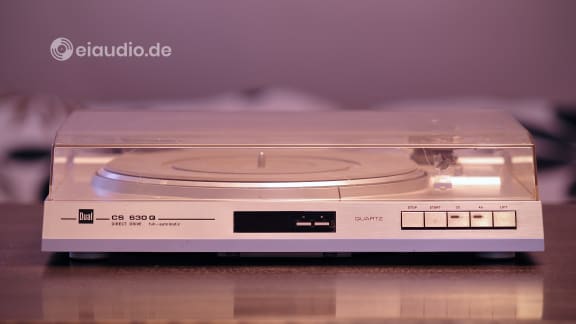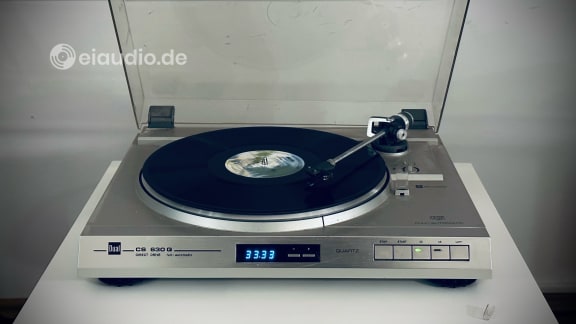Dual CS 630Q
Published: 16/03/2023
Manufacturing date: 1983
Author: Karsten Hein
Category: Gear & Review
Tag(s): Turntables
I confess that, when the Dual CS 630Q was brand new on the shelves during the early 1980s, I would have walked straight past it, only to marvel at the cleaner-looking and trendier Technics decks from Japan. And the sad demise of the Dual company alongside many other German manufacturers of quality audio gear during that same period suggests that I was not alone in this assessment. 40 years later, I am sitting in our studio listening to one Dual turntable after another only to find that we had been utterly wrong in ignoring them. But, as so many times in the history of mankind, we are only smarter after the fact.
During the 1980s, I was a teenager who had to stretch his allowance. More often than not, the money for HiFi gear came from my father. I mostly liked what my friends at school liked and what I was able afford. And this is also my excuse for purchasing a JVC AL-F3 as my first turntable, a mass-produced fully automatic direct-drive deck in plain black that can be found in mint condition for EUR 20.00 on ebay these days. Sellers of the Dual, on the other hand, usually for at least five times as much for their machine regardless of its condition. The trouble for Dual was that both turntables played music, and, as most people did not have the time, expertise, or equipment to compare the sound of turntables, the difference between the devices was a matter of marketing.
Japanese turntables often boasted the latest in technology, even before it was proven that this actually served the purpose better than established means. The S-shaped tonearm, turntable automation, and direct drive technology were cases in which German manufacturers were slow to follow the hype. The ULM tonearm, for example, did have excellent tonal and rhythmical characteristics on the Dual turntables. It was lightweight and torsion-free by which it could offer a forward drive that feels natural in music. Earlier idler wheel turntables and some well-engineered belt drives could very well compete with newer direct drive models and have remained favourite classics in many audiophile communities. And turntable automation has long since outlived itself, with modern decks often only having a single switch that is required to set the motor speed.
While Dual and other German manufacturers were seemingly out-classed in the 1980s, listening to the old decks perform suggested that they were still excellent choices when it came to their musicality, especially when played within a well-set-up system. The Dual CS 630Q that is presented here was handed down to my daughter from her recently deceased great aunt along with some other mid-Fi gear. Among the items were a Dual CV 1260 receiver (manufactured by Denon), a Dual CT 1260 tuner that was connected via 5-DIN plug, a Denon DCD 660 CD player, and two Canton GLX 100 bookshelf speakers that served to wrap up the ensemble. And, as the equipment had been sitting on a shelf for some years, I wanted to take the opportunity to run some routine checks and to present it in this forum.
Among these new devices, the CS 630Q interested me the most. I was already a great fan of the earlier and more elaborate Dual CS 721, for which I had built a walnut plinth for improved drive isolation. The CS 630Q was claimed to offer an improved signal-to-noise ratio paired with a more modern look. Where the famous Technics decks had a visible strobe light that reflected on iconic dots along the platter rim, Dual featured an accurate LCD display that interpreted the speed reading electronically. Dual’s legendary 4-point gimbal rested on adjustable tip bearings and served to stabilise the straight ultra-low-mass (ULM) tonearm well. The Start, Stop, and Lift buttons felt firm and gave great sensory feedback, and I also enjoyed the fact that the rotation speed adjustment was executed in the same manner. The record size was set separately via a selector switch located to the right of the tonearm. All in all, this seems like a well thought out design.
Modern users might object that the layer’s surface was not flat but instead showed all kinds of elevations and crevices. On the other hand, these oddities gave the CS 630Q its low silhouette and recognisable appearance. While I would not perhaps have thought of purchasing this Dual for myself, I did enjoy the look of it while it was perched on our makeshift audio sideboard with our experimental system in the studio. The system consisted of the Dual CV 1260 integrated amplifier and our Epicure 3.0 loudspeakers that had already shown that it worked very well together when playing from a CD source. I did have some difficulties adjusting the tracking force, because the automatic features got in the way of performing the action: Moving the arm towards the platter started the motor, and taking the Dual off the power grid automatically elevated the arm. There seemed to be no way out of this predicament, and I ended up adjusting the raised arm by also raising the tracking scales, which was probably not the most accurate method.
My reason for wanting to confirm and set the tracking force was due to an error that I could hear as sibilance on the inner LP tracks. The original ULM 66E cartridge had been replaced with an Ortofon DN 166 E which still seemed to work alright. I started my explorations with Fleetwood Mac’s 1977 album Rumours, of which I had the 2009 pressing. For a 70s album, Rumours offered a decent recording quality, as well as a wide range of songs that varied both tonally and rhythmically. Listening to the album with the CS 630Q for the first time, I also notice a humming that sounded like a grounding issue. I inspected the original cinch plugs and found that the metal grounding had corroded. The original plugs were already quite cleverly designed featuring a broken outer ring and a split centre prong. I decided to replace them with some decent modern standard Neutrik Rean, which were much less sophisticated in terms of sonic virtues, except for their debatable gold-plating, perhaps.
Looking at stylus options for the ULM/Ortofon cartridge, I came across the elliptical stylus that was now in place for about 75.00 EUR and then found the complete headshell with cartridge and Shibata stylus for just 14.00 EUR more. For my daughter learning to play records for the first time, the present stylus would do, but if this turntable had been mine for the keeping, I would have gone for the ‘Ortofon OM PRO S SH4 bl hs’ full package as advertised on the Thomann website, among others. For the time being, I set the tracking force with the scales on a CD case next to the rotating platter to 1.05g and the anti-skating to approximately half this value. I noticed that the Ortofon cartridge started to muffle the treble when the tracking force exceeded 1.25g. The original sibilance might have been caused by the anti-skating force exceeding the tracking force when, really, the opposite should be the case.
Fleetwood Mac’s album Rumours had started to sound just right, with a good amount of drive and swing. I enjoyed the amount of detail presented by the elliptical stylus, but I could also hear its limitations in terms of treble nuances. The higher the tone, the more it seemed to blend in with other high tones playing in the recording. This gave the music a robust and danceable presence rather than an audiophile experience. Bass on the other hand was tight and layered. I was able to get a good feel for the different materials of the drum set that stayed quite separate of the other instruments in “Don’t Stop Thinking About Tomorrow”. At the same time, I was missing some of the genuinely low bass frequencies that would have served the overall music impression well.
Considering the fact that the Dual CS 630Q already had a universal headshell mount, there was a wide range of cartridges available for the arm that were easy to swap and experiment with. While setting the tracking and anti-skating correctly improved the sibilance on the inner tracks, I was not able to eliminate it completely using the old stylus. The straight arm’s tracking error of 0.15° was, at least in my opinion, not large enough to explain the extent of the phenomenon. And it was sad as well, because “Songbird” was among my favourite tunes on the album. If I could only trust our kids and their friends (and the friends of their friends) to keep the stylus free from harm, I would be tempted to take that Ortofon SH4 offer.
Specifications
- Type: direct drive turntable
- Features: Fully automatic, with PLL quartz lock
- Microprocessor type: EDS 910
- Platter type: non-magnetic, removable
- Platter dimensions: (D) 304mm x (H) 10mm
- Platter weight: 1,170gr (700gr, without matt)
- Speeds: 33.33 and 45rpm
- Pitch-control: 30-36 RPM / 42-48 RPM
- Wow and flutter: +/- 0.035%
- Signal to noise ratio: 80dB, weighted
- Tonearm: distortion free ultra-low-mass tubular aluminium
- Gimbal: 4-point tip bearing
- Effective tonearm length: 211 mm
- Offset angle: 26°
- Tangential tracking error: 0,15°
- Headshell overhang: 19.5 mm
- Original cartridge: Dual ULM 66E
- Stylus-replacement: DN 166E
- Stylus-type: biradial diamond
- Tracking force: from 1 to 1.5g
- Frequency response: 10Hz to 28kHz
- Power consumption: 12,5 watts
- Compliance: (h) 35 / (v) 30
- Original cartridge weight: 2.0 g
- Dimensions: (W) 440mm x (H) 111mm x (D) 364mm
- Total weight: 5.5 kg
- Country of manufacture: Germany
- Year(s): 1983 - 1986







